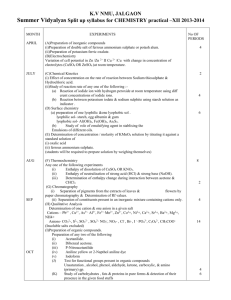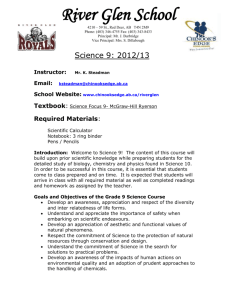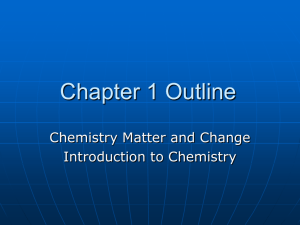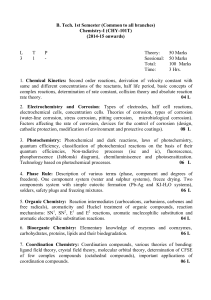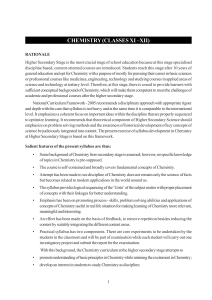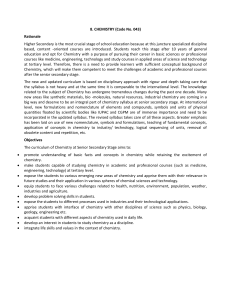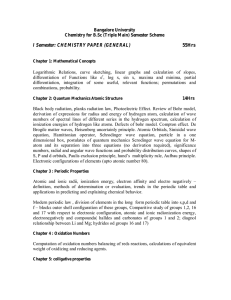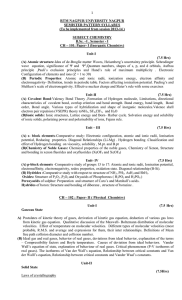Chemistry - KENDRIYA VIDYALAYA VIZIANAGARAM
advertisement
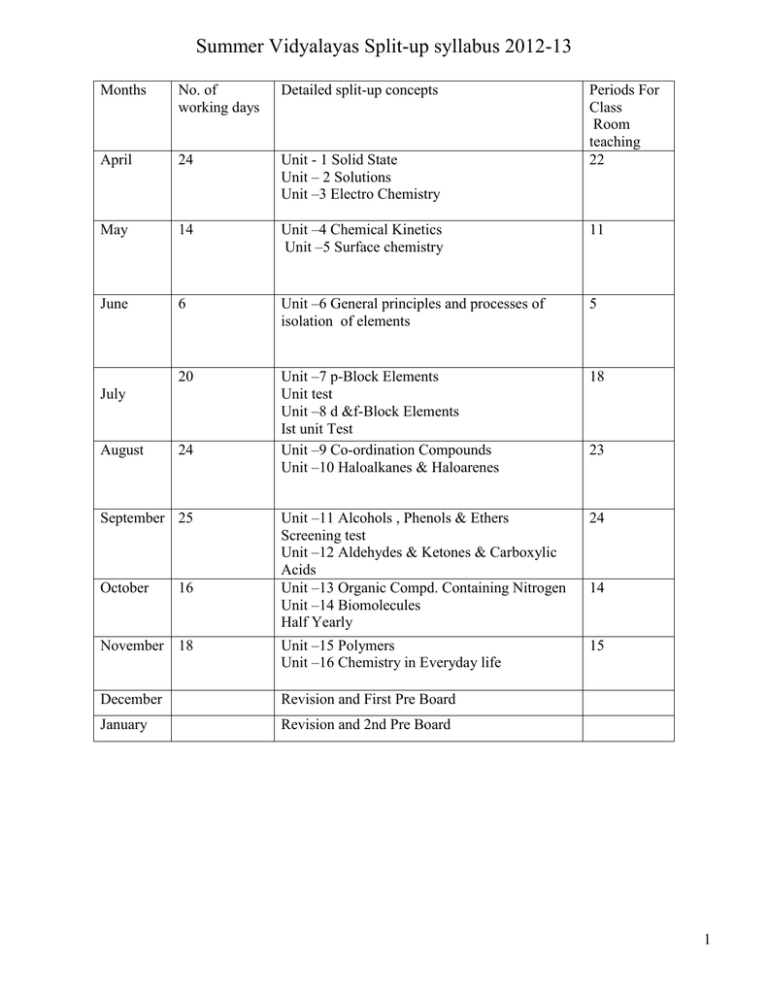
Summer Vidyalayas Split-up syllabus 2012-13 Months No. of working days Detailed split-up concepts April 24 Unit - 1 Solid State Unit – 2 Solutions Unit –3 Electro Chemistry May 14 Unit –4 Chemical Kinetics Unit –5 Surface chemistry 11 June 6 Unit –6 General principles and processes of isolation of elements 5 20 Unit –7 p-Block Elements Unit test Unit –8 d &f-Block Elements Ist unit Test Unit –9 Co-ordination Compounds Unit –10 Haloalkanes & Haloarenes 18 Unit –11 Alcohols , Phenols & Ethers Screening test Unit –12 Aldehydes & Ketones & Carboxylic Acids Unit –13 Organic Compd. Containing Nitrogen Unit –14 Biomolecules Half Yearly 24 November 18 Unit –15 Polymers Unit –16 Chemistry in Everyday life 15 December Revision and First Pre Board January Revision and 2nd Pre Board July August 24 September 25 October 16 Periods For Class Room teaching 22 23 14 1 Summer Vidyalyas Split up syllabus for CHEMISTRY practical –XII 2012-2013 MONTH APRIL JULY AUG SEP OCT EXPERIMENTS No OF PERIODS (A)Preparation of inorganic compounds (i)Preparation of double salt of ferrous ammonium sulphate or potash alum. (ii)Preparation of potassium ferric oxalate. (B)Electrochemistry Variation of cell potential in Zn /Zn 2+ II Cu 2+ /Cu with change in concentration of electrolytes (CuSO4 OR ZnSO4 )at room temperature. 4 (C)Chemical Kinetics (i) Effect of concentration on the rate of reaction between Sodium thiosulphate & Hydrochloric acid. (ii)Study of reaction rate of any one of the following :(a) Reaction of iodide ion with hydrogen peroxide at room temperature using diff erent concentrations of iodide ions. (b) Reaction between potassium iodate & sodium sulphite using starch solution as indicator . (D) Surface chemistry (a) preparation of one lyophilic &one lyophobic sol . lyophilic sol- starch, egg albumin & gum lyophobic sol- Al(OH)3, Fe(OH)3, As2S3. (b) Study of role of emulsifying agent in stablising the Emulsions of different oils. (E) Determination of concentration / molarity of KMnO 4 solution by titrating it against a standard solution of (i) oxalic acid (ii) ferrous ammonium sulphate. (students will be required to prepare solution by weighing themselves) (F) Thermochemistry Any one of the following experiments (i) Enthalpy of dissolution of CuSO4 OR KNO3. (ii) Enthalpy of neutralization of strong acid (HCl) & strong base (NaOH). (iii) Determination of enthalpy change during interaction between acetone & CHCl3 (G) Chromatography (i) Separation of pigments from the extracts of leaves & flowers by paper chromatography & Determination of Rf values. (ii) Separation of constituents present in an inorganic mixture containing cations only. (H) Qualitative Analysis Determination of one cation & one anion in a given salt Cations – Pb2+ , Cu2+, As3+, Al3+, Fe3+, Mn2+, Zn2+, Co2+, Ni2+, Ca2+, Sr2+, Ba2+, Mg2+, NH4+ Anions- CO32-, S2-, SO32- , SO42-, NO2-, NO3- , Cl- , Br_, I -, PO43-, C2O42-, CH3COO-. (Insoluble salts excluded) (I)Preparation of organic compounds. Preparation of any two of the following (i) Acetanilide. (ii) Dibenzal acetone. (iii) P-Nitroacetanilide (iv) Aniline yellow or 2-Napthol aniline dye (v) Iodoform (J) Test for functional groups present in organic compounds Unsaturation , alcohol, phenol, aldehyde, ketone, carboxylic, & amino (primary) gp. (K) Study of carbohydrates , fats & proteins in pure forms & detection of their presence in the given food stuffs Investigatory Project 2 4 6 8 2 4 14 4 6 2 3
